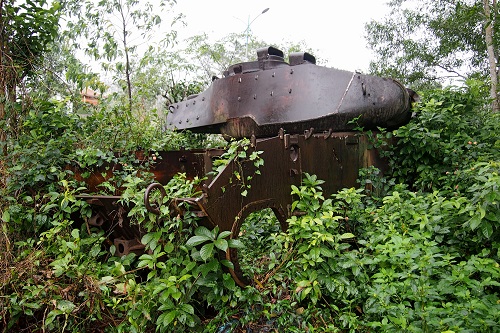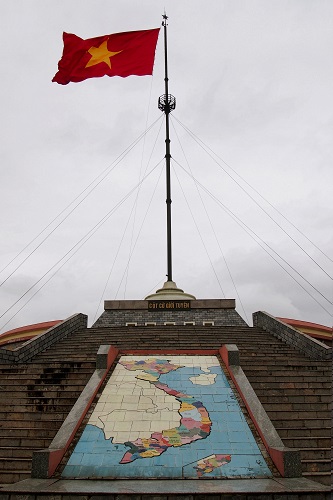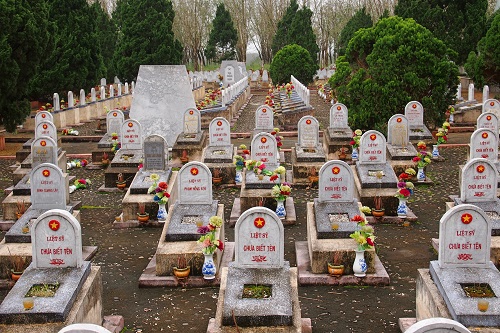The barren landscape stretched as far as the eye could see, pockmarked with crater holes and devoid of vegetation. Looking up from the photo our guide was holding, the modern day reality could not have been more different. There were trees and flowers here and the undergrowth was so dense we could barely see the view beyond. This area, around Vietnam's DMZ, was one of the most heavily bombed during the Vietnam War. We took a tour to see some of the lasting reminders of the conflict.
Doc Mieu Base - Bombarding The DMZ
Our first stop was Doc Mieu, an important American base just outside the DMZ. From here, the American artillery rained death and destruction on the DMZ and across the border into North Vietnam. Now, all that remains of the base is the rusting hulk of a tank. Entwined in vines, nature is slowly reclaiming this too.

The Tank At Doc Mieu
What Is The DMZ?
When North Vietnam and South Vietnam were separate countries, the border followed the Ben Hai River. 5 km either side of the border was designated a demilitarised zone or DMZ. Soldiers were forbidden from entering the area. When the country was reunified after the Vietnam War, the DMZ was removed.
Driving north, our guide, Hai, told us more about her memories of the Vietnam War. The area around Dong Ha and the DMZ was so heavily bombed that many families, including her own, evacuated.
When the war ended, Hai returned to Dong Ha and started at a new school. She recalled a boy there playing with a ball he had found. Too late, they realised it was an unexploded bomb. Hai showed us the scars still visible on her hand but conceded that she was one of the lucky ones. The boy didn't survive.
Deaths and injuries from unexploded ordnance were widespread in Vietnam after the war. Even when we visited, over 40 years later, we heard news of another victim.

Monument To The Families
Ben Hai River, The Heart Of The DMZ
Next, we stopped at the Ben Hai River, a murky torrent bisecting the DMZ. Statues of a mother and child stand on the riverbank, a monument to the families affected by the Vietnam War. They look north, waiting for their husbands and fathers to return.
We crossed the river, which marked the border, on an old metal bridge. The half of the bridge in South Vietnam was bright yellow. Stepping across a white line in the centre, we found ourselves in North Vietnam, where the bridge was blue. This version of Hien Luong Bridge is actually a replica, along with most of the buildings in the area. The originals didn't survive the war.

The Border

The Flag In North Vietnam
On the northern riverbank, we passed police checkpoints and a hut that had been used by the UN when monitoring the situation at the border. They withdrew when the war started. There was also a huge flagpole, a must for any self-respecting DMZ. The red flag flapping in the breeze was a wartime symbol of North Vietnam but it has since been adopted by the rest of the country as well.
The only original artefacts we saw in this area were in the museum. A grand collection of bomb casings and landmines were displayed alongside graphic photos illustrating their devastating effects. Many showed soldiers and villagers in the cratered wasteland around the DMZ. The worst pictures however, showed children maimed by unexploded bombs after the war had finished.
The Lasting Effects Of Agent Orange
Leaving Highway 1, we drove through acres of farmland heading for the coast. We passed leafy fields of taro and neat rows of pepper vines. There were also groves of rubber trees, each slashed and bandaged with a tiny bowl strapped to its trunk collecting latex.
This was very different to the wartime landscape Hai was describing to us. In the Vietnam War, as well as the bombing, the DMZ was decimated with napalm and agent orange. After the war, locals found the discarded metal containers that had been used to transport the agent orange. Not realising they were contaminated, these containers were used for cooking and carrying water. This may have been responsible, at least in part, for the post-war increase in cancers and birth defects.

Meeting Room, Vinh Moc Tunnels
Vinh Moc Tunnels
A few miles north of the DMZ, we arrived at the Vinh Moc Tunnels. Although many families evacuated this area during the war, some stayed behind. They helped to maintain vital supply lines to North Vietnam. During the worst of the bombing, these families needed somewhere to hide. They dug a network of tunnels so extensive that it's more like an underground village.
Uncomfortably bent double, we explored the humid passages passing many tiny alcoves where whole families would have lived for days at a time. The Vinh Moc Tunnels were well equipped with a meeting room, shower room and a well. There was even a maternity room where a total of 17 babies were born.

The War Cemetery
Identifying Unknown Soldiers
Our final stop was at a war cemetery. The rows of identical graves were well kept, each topped with incence sticks and a vase of artificial flowers. Most were marked 'Chua Biet Ten', unknown name.
We noticed some of these graves had another headstone in front of the first. These were added later, after the unknown soldier within had been identified. Curious to know how this was even possible, Hai explained. Some families had hired the services of a medium to find their loved ones. They used their psychic powers to locate the exact grave, with no more than a short walk around the cemetery.
Leaving the cemetery, we passed the Doc Mieu tank again and tried to catch a glimpse of the view. Now lush and green, it's clear the landscape around the DMZ has recovered. However, despite the outward appearance, a legacy of unmarked graves and unexploded bombs still scars the region.

Graves To Unknown Soldiers
How To Get To Vietnam's DMZ
Dong Ha is very close to Vietnam's DMZ and makes a great base for exploring the area. However, you can also take a longer day trip from Hue.
A DMZ tour is a good way to see the numerous sites of interest in this area. With a full-day tour you can see the highlights on both Highway 1 and Highway 9. A half-day tour will only cover one of these roads. We chose Highway 1 as it included the Vinh Moc Tunnels, which are well worth visiting.
The cheapest tour option is a group bus tour. These operate on a very tight schedule. If you would rather see things in your own time, it is better to hire a car and driver. If you do go for the car option, it is worth spending the extra to have a local guide accompany you.

One thought on “Touring Vietnam’s DMZ: Tanks, Tunnels And Psychic Powers”